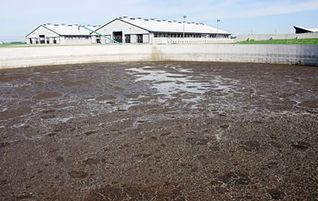 Manure Pit from https://ajyoung0224.wordpress.com/2014/05/
Manure Pit from https://ajyoung0224.wordpress.com/2014/05/ I have worked with several facilities to see if biological waste treatment techniques can help improve animal health in the high density houses and improve both manure handling and biological treatment. Through several years of studying the natural bioprocesses in the houses and feed lots, there are three main areas where biological waste treatment technologies can be used.
Ammonia & H2S Control in Houses
Manure accumulates on the house floors and rapidly releases ammonia in highly toxic gas form if the pH is above 8.0. The ammonia causes eye and lung irritation that can lead to both higher disease susceptibility and lower weight gain. In addition to ammonia, anaerobic conditions can promote anaerobic bacteria that produce hydrogen sulfide – an extremely toxic gas.
In recent trials, we have used select microbes and enzymes to initiate waste degradation in the house. The microbes have proven effective in keeping ammonia below critical levels (< 25 ppm) and keeping hydrogen sulfide under control. This technology works by initiating the manure degradation in the house a process which also helps lower enteric and pathogenic bacteria on the floors and bedding. It is important to select microbes that are effective at degrading animal wastes, producing extracellular enzymes, and have documented abilities to competitively exclude enteric and other pathogenic species in a working environment.
Manure Solids Reduction/Liquefaction & Fly/Insect Control
While the same microbes are used here as in ammonia control, the process of converting manure solids into liquefied form for pumping into treatment units or ponds. In houses with manure pits, the solids can buildup creating a crust. The crust becomes dry and provides an excellent insect breeding site. Under the crust, anaerobic activity creates odors and hydrogen sulfide. These pits can be treated with microbes to keep the crust from forming and to reduce the tendency of solids to buildup and crust on the pit. The bacteria are applied during pad washing and also through direct spray on the crust surface.
Manure Biological Treatment in Ponds/Lagoons
Following pumping from the houses and pens, the waste liquid is most often treated in ponds or lagoons with mixing/aeration. The goal in these ponds is to reduce the BOD5, ammonia, and fecal coliforms from being discharged. Often these ponds experience solids buildup that reduces residence time eventually compromising treatment efficiency. In this case, we have worked to optimize biological activity and improve mixing to suspend the solids. With the solids better suspended, microbes with high extracellular enzyme production can work to degrade the organic fraction of the solids thereby reducing sludge buildup on the pond bottom. We have often seen 3 – 4 feet of sludge decrease in volume to less than 1 foot during trials. The effectiveness depends upon the percent organic and entrapped water in the sludge along with the amount of mixing.

 RSS Feed
RSS Feed